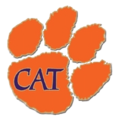 | |
| Founded | January 8, 1996 |
|---|---|
| Headquarters | 200 West Lane Clemson, South Carolina 29631 |
| Locale | South Carolina |
| Service area | Clemson and Clemson University with service to Seneca, Central, Southern Wesleyan University, Pendleton, Tri-County Technical College, Anderson and Anderson University |
| Service type | Local and Student Commuter |
| Routes | 8 |
| Annual ridership | 891,700 (2024) [1] |
| Fuel type | Electric, Diesel |
| Operator | Clemson University, Tri-County Technical College, Anderson University, Southern Wesleyan University, Town of Pendleton, Town of Central, South Carolina Information Highway (SCIWAY), City of Clemson, City of Seneca |
| Chief executive | Keith Moody |
| Website | catbus |
Clemson Area Transit, a zero-fare bus line known locally as CAT or the "CAT Bus", is the most frequently used transit system in South Carolina. Areas with bus service include Clemson University, the City of Clemson, the County of Anderson, City of Seneca and the Towns of Central and Pendleton. The headquarters of the organization is in the City of Clemson. [2]
Contents
The fare-free system is made possible by federal grants and matching funds from the city and University. CAT operates a modern fleet of buses, including over 10 forty foot long Proterra electric buses, 7 forty foot long NOVA low-floor buses, and two sixty-two foot long articulated NOVA buses dubbed the "Caterpillars"- the first and only two articulated bus currently operated in South Carolina. In 2024, the system had a ridership of 891,700. Utilizing multiple routes and lines, CAT Buses help transport citizens and students from campus or downtown to surrounding neighborhoods and apartment complexes, and move travelers from the Clemson area to surrounding communities.
The service is jointly operated by the City of Clemson, Clemson University, the Town of Pendleton, City of Seneca, Southern Wesleyan University, and the Town of Central
